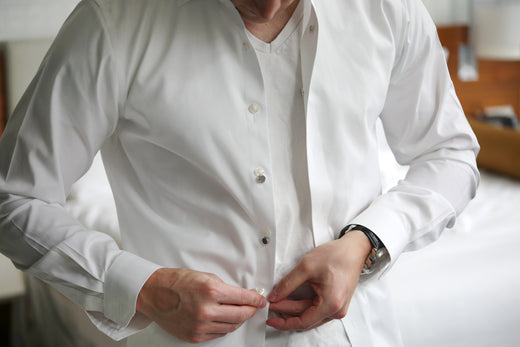Undershirts: Why You Should Wear Them, and How to Do It With Style

In the world of men's fashion, the humble undershirt is an unsung hero. Though not visible, a well-chosen undershirt can make a significant difference in the comfort, appearance, and style of an ensemble.
From its historical roots to its modern-day versatility, the undershirt plays a crucial role in maintaining a polished and sophisticated look.
Are you aiming for a sleek silhouette under a dress shirt? Or seeking a sweat- and odor-absorbing layer in hot months? Need an extra layer of warmth in cold months? Whichever the scenario - understanding the nuances of undershirts will elevate your fashion game as well as your confidence level.
In this article, we'll explore the history of the undershirt, provide practical tips on when and how to wear one, and answer these frequently asked questions along the way:
- What should I wear as an undershirt?
- When should guys wear undershirts?
- How to choose the right undershirt?
- Should undershirts be tight or loose?
- Should undershirts always be white?
- How do you not see an undershirt under a white button down?

A Brief History of the Undershirt
The purpose of the undershirt has remained consistent since its introduction: comfort and hygiene.
In ancient civilizations, people wore tunics and other simple garments under their outerwear to protect their skin from rough fabrics and for warmth.
Later, during World War I, the U.S. Navy introduced a lightweight, short-sleeved, crew-neck cotton undershirt as part of its standard-issue uniform. These undergarments provided an extra layer of warmth, absorbed sweat, and reduced friction between the skin and the heavier outer layers of the uniform. By World War II, all branches of the military issued similar undershirts.
Soldiers often wore their undershirts as a standalone garment in hot climates and, after their service, continued to wear them in civilian life. During the 1950s, Hollywood icons like Marlon Brando and James Dean – who wore them in films such as A Streetcar Named Desire and Rebel Without a Cause – made the undershirt a symbol of rebellion and coolness, significantly impacting its evolution into the T-shirt.

James Dean, Rebel Without a Cause - Image Source: Wikipedia
How the Undershirt Became the "Wife Pleaser"
In time, the sleeveless undershirt was, unfortunately, nicknamed the “wife beater” – a problematic term due to its negative connotations. This name came from broader societal attitudes that linked working-class men, especially those in physically demanding jobs, with violent behavior. This stereotype was unfair and damaging but persisted in popular culture.
Today, some brands and fashion enthusiasts have put a more positive spin on the sleeveless version of the garment, calling it the "wife pleaser" instead. This rebranding effort is appreciated by many, especially as this undershirt style continues to be a popular choice for its practicality and modern appeal.
What's An Undershirt, Anyway?
Though the undershirt and T-shirt have a shared history, they are not the same and are purchased to fulfill different needs. Both can serve as base layers, but the distinctions are clear.
Undershirt vs T-Shirt
- Undershirts are intended to be worn under clothing; T-shirts are designed to be worn as a singular item.
- Undershirts are typically lighter and more form-fitting, providing a smooth, invisible layer that absorbs sweat. T-shirts are heavier and often more structured; they are less likely to fit snugly under another shirt without adding bulk.
- Undershirts come in various styles, including crew neck, V-neck, and tank tops, and are often made from advanced fabrics that offer moisture-wicking and temperature-regulating properties. The run-of-the-mill T-shirt has a crew neck and is typically made from cotton or a cotton blend.
So, the question of what to wear as an undershirt is easy to answer. For a polished look, an undershirt is the better choice. It’s specifically designed to provide comfort without compromising style.

When To Wear An Undershirt?
Undershirts are an essential component of a well-dressed man's wardrobe, especially when it comes to formal, semi-formal, business casual, and cocktail attire. Here’s a detailed look at when and why undershirts should be worn.
Under Button Downs
In formal and semi-formal settings, such as weddings, black-tie events, business meetings, and networking events, wearing an undershirt with your button down is highly recommended. It helps create a smooth and polished appearance and ensures your outerwear remains fresh and presentable throughout the day or event.
To Prevent Transparency
Light-colored dress shirts, common in formal and semi-formal attire, can sometimes be semi-transparent. An undershirt prevents any potential embarrassment by ensuring that your skin and chest hair are not visible.
To Enhance Fit & Comfort
A well-fitted undershirt can improve the overall fit of your dress shirt, making it look more tailored and streamlined. It also adds an extra layer of comfort, preventing the dress shirt from feeling scratchy or rough against the skin.
To Regulate Temperature
The undershirt helps regulate body temperature. It absorbs sweat, keeping you cool and preventing any unsightly damp patches that could ruin the appearance of your dress shirt.

Choosing The Right Undershirt
Selecting the perfect undershirt – especially an undershirt under a white dress shirt – involves considering several key factors to ensure comfort, functionality, and a polished appearance.
-
Fabric
- Look for breathable and moisture-wicking materials like cotton or cotton blends.
- Fabrics such as modal or bamboo offer added softness and comfort.
- Choose materials that provide good stretch and durability.
-
Color
- Undershirts don’t have be white! Neutral colors like white, gray, beige, and nude are versatile and discreet under most shirts.
- Choose an undershirt closer to your skin color under white and light-colored dress shirts to prevent them from showing through.
-
Black undershirts work well under dark clothing.
* Here is an example of a visible undershirt under a button down. A better solution would have been a thicker dress shirt, or not to wear an undershirt at all.

-
Fit
- The undershirt should be form-fitting but not too tight to avoid discomfort and restriction of movement.
- A snug fit ensures the undershirt remains discreet and doesn't bunch up under outer layers.
- Avoid loose undershirts – especially under white and light-colored dress shirts – as they can create a bulky appearance and defeat the purpose of a smooth layer.
-
Neckline
- Crew Neck: Ideal for fully buttoned shirts or if you prefer a more traditional look.
- V-Neck: Suitable for shirts with the top button open, ensuring the undershirt remains hidden.
- Deep V-Neck: Perfect for more open collar styles or casual unbuttoned looks.
-
Length
- The undershirt should be long enough to tuck into your pants to prevent it from riding up throughout the day.
- A longer length ensures that the undershirt stays in place, maintaining a neat and tidy appearance.
At R. Hanauer, we are committed to helping gentlemen feel confident in their menswear on an everyday basis. Our Instagram and Facebook feeds are a great source of information and inspiration, and our blog – The Gentleman’s Guide – is an excellent resource for all sartorial things. Here are some of our most popular articles from our All About Bow Tie Accessories series!
- How To Pair a Bow Tie and Pocket Square
- Bow Tie Fashion Rules
- The Art of Coordination: Should Socks Match Pants, Shoes, Suits, or Ties?
- What Color Shoes to Wear With Your Suit
- The Corporate Beard: How Facial Hair Can Boost Your Professional Image
- Hats Off: How to Avoid a Style Faux Pas with Modern Hat Etiquette
- Unlock the Power of Style with Cufflinks: When & How to Wear Them
- How to Wear a Tie Clip
- Is the Handkerchief Dead? Exploring the Practicality and Style of a Timeless Accessory
- How to Wear a Cummerbund

